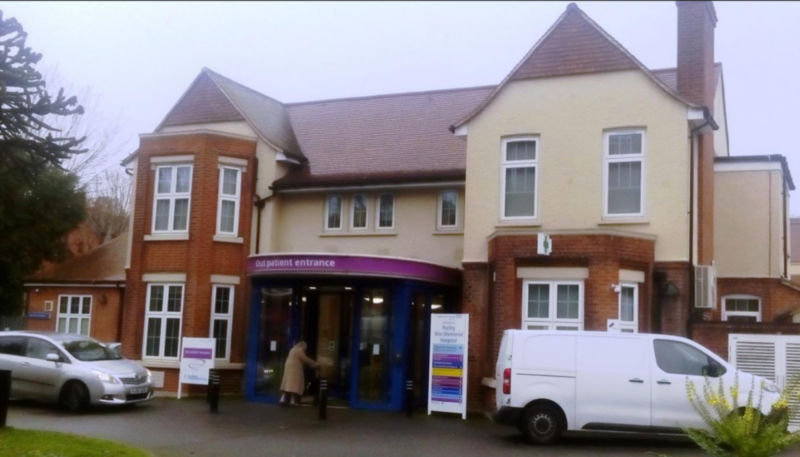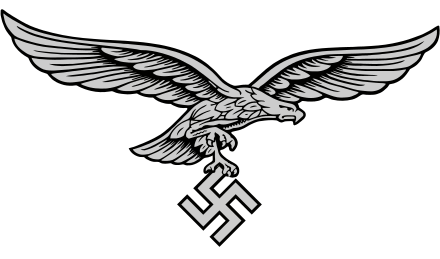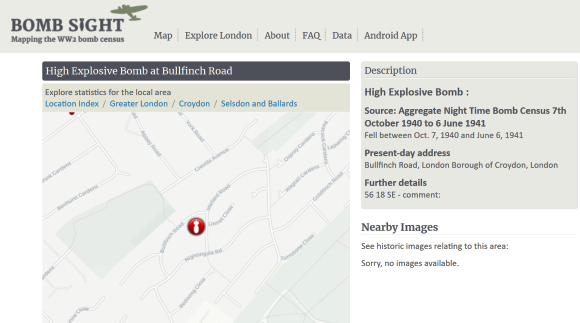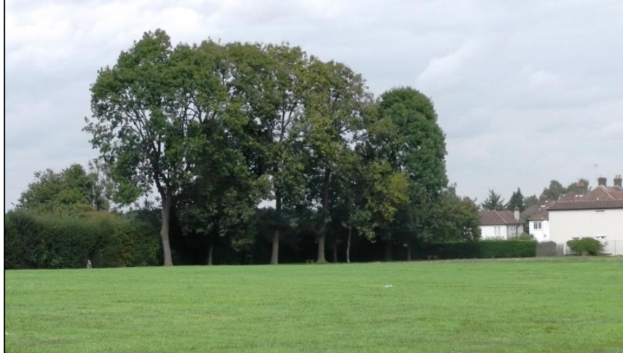1939 to 1945 – Through the Eyes of a War Baby
After the slaughter of the trench warfare during the First World War, every little village in the country has a memorial to remember their young men who never came home. The Purley War Memorial Hospital was built to serve this function. But times had changed, it was not trench warfare, but air warfare that played a dominant role, especially at the start of World War II. This war started for us in the UK, with the Declaration of War on the 3rd September 1939. Less than a month later I was born at Purley War Memorial Hospital on 1st October 1939. From then until 1963 I lived with my family at Abbey Rd in Selsdon. So I really can claim to have served my time as a War Baby during WW II.

For Selsdoners, the war began on the evening of 15th August 1940. Or to be more correct, not on the 15th, but over. This fateful day, right at the beginning of the Battle of Britain, was when the Luftwaffe mounted a surprise attack on Croydon Airport. It was also a surprise for the Germans, because their intended target was Kenley Aerodrome, a much more important military airfield!

Navigation was very basic at the start of the war so the German bombers were following railway lines which were clearly visible from the air. Their route plan was to follow the railway line from the south coast to East Grinstead and then on to Kenley. Here, the very visible chalk pit beside the railway line along the Godstone Rd, was their marker to do a left turn to home in on to the adjacent airfield. Fortunately for Kenley but unfortunately for Croydon, the North Downs hump led them astray. The railway line disappears through a tunnel under Marden Park, to exit by Woldingham railway station. The tunnel confused the German bombers, who lost their way, went off course and instead attacked Croydon Airport.
The noise of bombs exploding, anti-aircraft guns, and the ensuing melee of German bombers, with their protective support fighters, being chased and machine gunned by the British fighters, brought Selsdoners out into their gardens to view this exciting and noisy spectacle in the sky above. Of course I didn’t see this, being only about 10 months old and asleep in my cot, but I have heard the story many times from my Mum and others who did.
So what are my earliest memories?
For me, it was the latter part of the Blitz which ended in June 1941. Due to heavy losses the Luftwaffe changed their tactics from day time to night time raids. My earliest memories are of being brought downstairs from my cot, wrapped in a blanket, to fall asleep hiding under the stairs until the “All clear” siren sounded. This spot, the cupboard under the stairs, being the safest place to shelter if you didn’t have a proper air raid shelter, which we didn’t. So many nights were spent in this routine with the four of us, Mum, Dad, me and my elder brother Michael, in this cramped small space. And of course, not forgetting the gas masks with which we were all issued!
There was one occasion that I can specifically remember. It was when a high explosive bomb fell in what we children called the “back fields.” So named because they were at the back of the houses in Greville Ave. These fields are now built over as part of the Ashen Vale housing estate, but in my childhood days some were used for growing food and some left fallow. The fallow fields were our playgrounds, and the large crater from this high explosive bomb became a favourite place in which to play.
The bomb was dropped during a night raid and the blast showered me and my cot with glass as the bedroom windows were blown in. Our back door was blown off its hinges and the front door burst its locks from the force of the blast. Fortunately no injuries to me are anyone else!
Now, with the aid of the internet I have been able to find out more about the date when this bomb fell. The bomb was dropped during the night time Blitz, some time between the 7th October (a week after my first birthday!) and 6th June 1941. And this is taken from official records made available here, see:
http://bombsight.org/bombs/20779/

The map shown is of the area as it is today, with the bomb’s location shown in Bullfinch Rd in the new Ashen Vale housing estate. To the left of the bomb, the shaded area is the still existing recreation ground at the south western end of Greville Ave. You can just make out a dotted line running from the “Rec” to Bullfinch Ave. That was a footpath, our route to play in the back fields and the bomb site – Happy days!
I should perhaps point out, that the Germans did not just drop bombs, but “sticks” of bombs. These multiple bombs would spread out in a random line in the wake of the plane. For example there was a bomb site in the Addington Rd, a bombed out bungalow near the bottom of York Rd, and just the base of a demolished semi on the corner of York Rd/Greville Ave. These are all in a rough line with my bomb crater in the back fields , probably all from the same stick of bombs.
My knowledge of the bombing raids was then restricted to the local area within walking distance. It is only now, by seeing the location of bombs which fell in and around Selsdon during the Blitz that I can realise how bad it was. Croydon is dead centre, below.

However this web site is only part of the picture. Bombing raids continued but at a much lesser level after the Blitz, and of course there were still the V1 flying bombs to come – one of which fell in Ingham Rd which was next to our school – a lucky miss for us children.
The Borough of Croydon had the highest number of hits by V1 flying bombs of all the London Boroughs!
I can for example remember on one occasion, going to the shops in Selsdon with my mother, to find that an incendiary bomb had left a burnt out shell at the bottom of Kingsway Ave. The day before it had been a house! And there was a short cut to the shops by going over a bomb site in Sundale Ave (previously a row of terraced houses) into Dulverton Rd, and then along the footpath into the Addington Rd by where Aldi now is. When I grew older, my friends and I used to go out and explore the gardens and ruins of several of our local bomb sites. These also became our adventure play grounds.
Life to some extent was then dominated by two things – air raids and shopping. Let me start with air raids. I have already mentioned that we didn’t have an air raid shelter, but both our next door neighbours did. On our right was the Penson family who had an above ground, brick built shelter protected by sand bags. Mr Penson was away serving in the RAF. On our left were the Blagdens who had the more common, Anderson shelter. These were of corrugated iron sheet construction, buried in the ground. Mr Blagden was away serving in the army. Next door to the Blagdens was the Smith family. Mr Smith was in the Royal Navy and the last dad to come home after the war ended.
My Dad served in the First World War so was too old for military service. Instead he was on a roster to do night time fire watch from the top of his office building in London. Very important during the Blitz when incendiary bombs were most common.
Most households did have a shelters, but additionally there were several public shelters dotted about Selsdon, so it was not a problem for us to find shelter when out playing with friends or shopping with my Mum.
My house backed on to Selsdon Recreation Ground, or the “Rec” as we called it. There was a purpose built Air Raid Wardens Post here, hidden within a clump of trees, and next to it an air raid siren. The location below, as it is today.

The post was manned 24 hrs a day, to sound the alarm and respond to injury/damage as a result of any bombing incidents. Another important job for them, was to patrol the streets at night to check and to rigidly enforce the blackout. We had thick blackout paper fixed with drawing pins to all the window frames. The slightest chink of light brought a knock on the door and dire warnings from the Air Raid Wardens – this was a serious offence!
Also in the Rec was a purpose built, public air raid shelter. It’s location is still just identifiable, being the vestiges of what was originally a long and high, raised bank, with trees behind. It is beside where the post war swings and see-saw were later installed. The long, underground shelter had entrances at each end, and an emergency escape hatch in the centre of the tunnel. The hatch was reached via iron rungs set in a vertical shaft.

The first time that I actually saw a doodlebug was from this shelter. A doodlebug was the common name for the V1 flying bombs. It was a sunny summer’s day and I was playing with friends in the woods in the Rec, when the siren went off, so we didn’t have far to run. Soon after, the phut-phut-phut of the pulse jet engine, indicated that the V1 had (safely for us) passed over. One of the men who was at the shelter entrance, shouted that he could see the small, winged missile continuing on towards London. I rushed out of the shelter to get my first sighting of a flying bomb!

This bomb shelter had another important role to play for us young children. It was our Aladdin’s cave! When not being occupied for its intended use so the emergency lighting off, it was a long, pitch black tunnel. We kids would feel our way through from one end to the other. And as we grew older and taller, we could climb up the rungs and out through the escape hatch. The underground shelter continued to serve this purpose for some years after the war ended. It was a huge loss when our tunnel was filled in and the entrances and central exit were concreted over.
Also gone is the sound of the warning sirens and their “all clear”. After the war these fell silent but were brought back into use during the cold war. They were planned to be used to advise us of a nuclear strike, and /or an ensuing windblown cloud of nuclear radiation. We again heard the familiar wail when the sirens were tested out. It may seem strange but when the sirens finally fell silent, I really missed the haunting sound of the siren and the all clear.
The arrival of the V1- flying bombs in early 1944 coincided with an even more historic event – the D-Day landings! Un-beknown to me then, I was seeing small bits of the complex jigsaw that was being put together. There was increased air activity. Huge waves of bombers flying over, heading south to pound the German fortifications in Northern France. Also support fighters, attack fighters, and of course troop movements.
The latter were more evident as they were close by, only feet away. Long columns of army lorries, armoured cars, jeeps, field guns and much more as they noisily trundled up the Addington Rd whilst we were on our almost daily shopping trips. This was part of the build up of troops who were shortly to set sail from the south coast for the beaches of Normandy.
In late 1944 I started school at Selsdon Primary. An important part of my early learning took place in the school’s air raid shelters. This was due to the regular phut-phut as doodlebugs flew overhead. So my earliest years span all but 3 weeks of war time Selsdon.
Des
